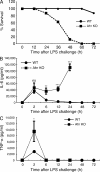Aryl hydrocarbon receptor in combination with Stat1 regulates LPS-induced inflammatory responses
- PMID: 19703987
- PMCID: PMC2737163
- DOI: 10.1084/jem.20090560
Aryl hydrocarbon receptor in combination with Stat1 regulates LPS-induced inflammatory responses
Abstract
Toll-like receptor (TLR) signals perform a crucial role in innate immune responses to pathogens. In this study, we found that the aryl hydrocarbon receptor (Ahr) negatively regulates inflammatory responses mediated by lipopolysaccharide (LPS) in macrophages. Ahr was induced in macrophages stimulated by LPS, but not by transforming growth factor (TGF)-beta plus interleukin (IL)-6, which can induce Ahr in naive T cells. The production of IL-6 and tumor necrosis factor (TNF)-alpha by LPS was significantly elevated in Ahr-deficient macrophages compared with that in wild-type (WT) cells. Ahr-deficient mice were more highly sensitive to LPS-induced lethal shock than WT mice. Signal transducer and activator of transcription 1 (Stat1) deficiency, as well as Ahr deficiency, augmented LPS-induced IL-6 production. We found that Ahr forms a complex with Stat1 and nuclear factor-kappa B (NF-kappaB) in macrophages stimulated by LPS, which leads to inhibition of the promoter activity of IL-6. Ahr thus plays an essential role in the negative regulation of the LPS signaling pathway through interaction with Stat1.
Figures





References
-
- Akira S., Takeda K. 2004. Toll-like receptor signalling.Nat. Rev. Immunol. 4:499–511 - PubMed
-
- Basu S., Dunn A.R., Marino M.W., Savoia H., Hodgson G., Lieschke G.J., Cebon J. 1997. Increased tolerance to endotoxin by granulocyte-macrophage colony-stimulating factor-deficient mice.J. Immunol. 159:1412–1417 - PubMed
-
- Bettelli E., Carrier Y., Gao W., Korn T., Strom T.B., Oukka M., Weiner H.L., Kuchroo V.K. 2006. Reciprocal developmental pathways for the generation of pathogenic effector TH17 and regulatory T cells.Nature. 441:235–238 - PubMed
-
- Beutler B., Rietschel E.T. 2003. Innate immune sensing and its roots: the story of endotoxin.Nat. Rev. Immunol. 3:169–176 - PubMed
-
- Bonnesen C., Eggleston I.M., Hayes J.D. 2001. Dietary indoles and isothiocyanates that are generated from cruciferous vegetables can both stimulate apoptosis and confer protection against DNA damage in human colon cell lines.Cancer Res. 61:6120–6130 - PubMed
Publication types
MeSH terms
Substances
LinkOut - more resources
Full Text Sources
Other Literature Sources
Molecular Biology Databases
Research Materials
Miscellaneous

